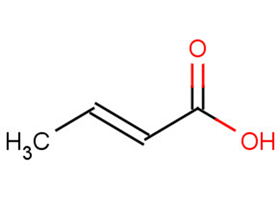
Crotonic acid
CAS No. 107-93-7
Crotonic acid( alpha-butenoic acid )
Catalog No. M19987 CAS No. 107-93-7
Crotonic acid is fatty acid formed by the action of fatty acid synthases from acetyl-CoA and malonyl-CoA precursors. It is involved in the fatty acid biosynthesis. It is also found in water extracts from carrot seeds (Daucus carota L.).
Purity : >98% (HPLC)
 COA
COA
 Datasheet
Datasheet
 HNMR
HNMR
 HPLC
HPLC
 MSDS
MSDS
 Handing Instructions
Handing Instructions
| Size | Price / USD | Stock | Quantity |
| 5MG | 49 | In Stock |


|
| 100MG | Get Quote | In Stock |


|
| 200MG | Get Quote | In Stock |


|
| 500MG | Get Quote | In Stock |


|
| 1G | Get Quote | In Stock |


|
Biological Information
-
Product NameCrotonic acid
-
NoteResearch use only, not for human use.
-
Brief DescriptionCrotonic acid is fatty acid formed by the action of fatty acid synthases from acetyl-CoA and malonyl-CoA precursors. It is involved in the fatty acid biosynthesis. It is also found in water extracts from carrot seeds (Daucus carota L.).
-
DescriptionCrotonic acid is fatty acid formed by the action of fatty acid synthases from acetyl-CoA and malonyl-CoA precursors. It is involved in the fatty acid biosynthesis. It is also found in water extracts from carrot seeds (Daucus carota L.).
-
In Vitro——
-
In Vivo——
-
Synonymsalpha-butenoic acid
-
PathwayOthers
-
TargetOther Targets
-
RecptorOthers
-
Research Area——
-
Indication——
Chemical Information
-
CAS Number107-93-7
-
Formula Weight86.09
-
Molecular FormulaC4H6O2
-
Purity>98% (HPLC)
-
SolubilityDMSO:10 mM
-
SMILESC\C=C\C(O)=O
-
Chemical Name——
Shipping & Storage Information
-
Storage(-20℃)
-
ShippingWith Ice Pack
-
Stability≥ 2 years
Reference
1.Sethi JK et al. Thematic review series: adipocyte biology. Adipose tissue function and plasticity orchestrate nutritional adaptation. J Lipid Res. 2007 Jun;48(6):1253-62.
molnova catalog



related products
-
Moiramide B
Moiramide B is a potent acetyl coenzyme A carboxylase (ACC) inhibitor (IC50:6 nM) with antimicrobial activity, strongly inhibiting Gram-positive bacteria but weakly inhibiting Gram-negative bacteria.
-
Ganoderol A
Ganoderol A has significant anti-inflammatory activity and protection against UVA damage.
-
2-Acetamidophenyl 5-...
phosphodiesterase 7 inhibitor.



 Cart
Cart
 sales@molnova.com
sales@molnova.com


